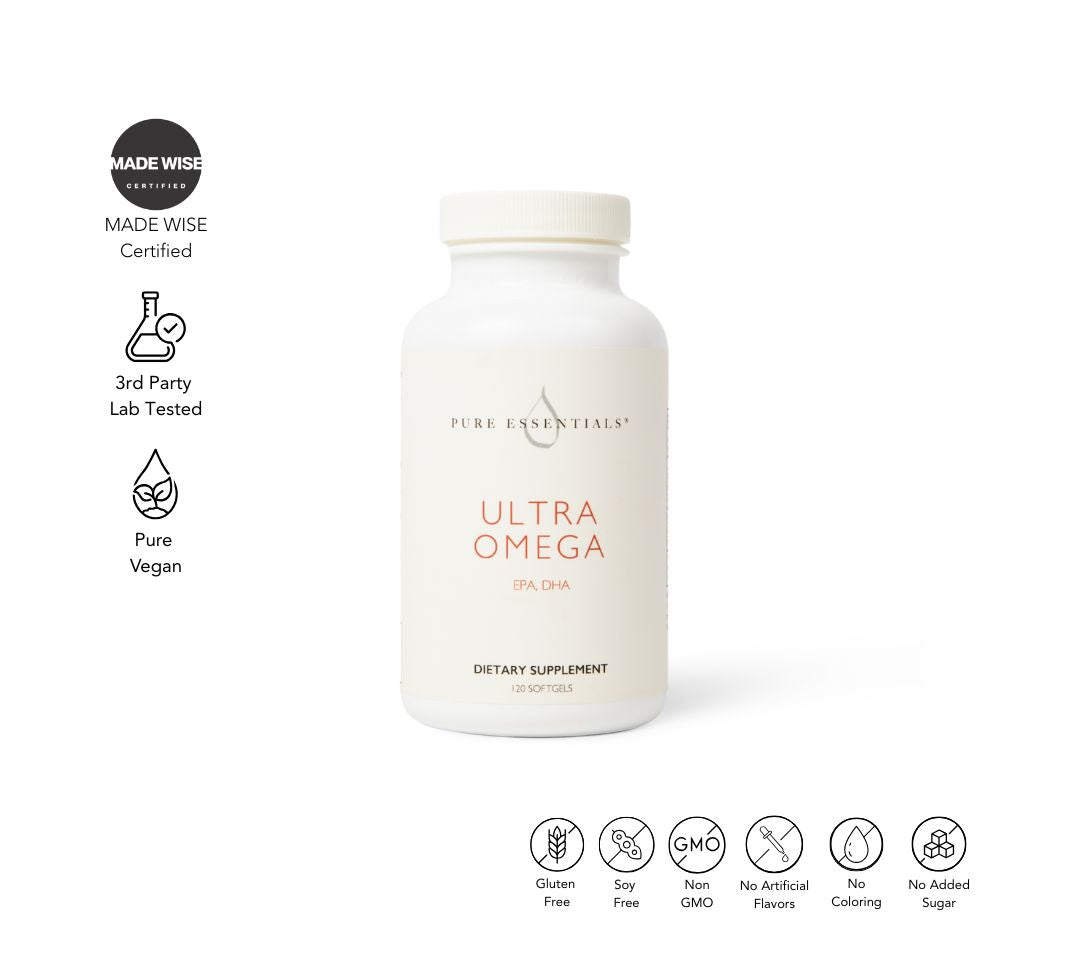summary
Omega-3 and omega-6 fats are essential for health, but imbalances can cause inflammation, heart disease, and mental health issues. Omega-3s reduce inflammation and support brain function, while excess omega-6 can lead to chronic health problems. Improving omega-3 intake through diet or supplements is crucial for achieving balance and better health.
Omega-3’s, omega-6’s and trans fats play a key role in our heart, brain, and metabolic health.
Low omega intake can contribute to chronic illnesses like rheumatoid arthritis, heart failure, atherosclerosis, diabetes, and even depression. Omega-3 intake may be beneficial in reducing risks for Alzheimer’s disease, dementia, and even some cancers.
Knowing that you need omega-3’s is great. Knowing how much may be a different story.
Pure Essentials Omega-3 Index Plus test is designed to make knowing your omega status easy and deciding how to remedy the situation even easier!
The Omega-3 Index Plus Test measures the amount of EPA / DHA in your red blood cells, specifically in the membrane. Membranes (the cell wall) are made up of fatty acids. The amount of fatty acid (EPA / DHA) in the membrane reflects how much omega-3 is in your diet – making it a good marker of better health. Your omega-3, omega-6, trans fat, and other fatty acid markers can all be changed with diet…except that every body is different and each one responds differently.
That makes personalized nutrition so important. The only way to manage it is to measure it.
What are the signs & symptoms you may be omega-3 deficient?
Dry Skin and Hair - Omega-3s help maintain the skin's lipid barrier, keeping it hydrated and supple. Deficiency can lead to dry, flaky skin and brittle hair.
Frequent Infections - Omega-3s support the immune system by reducing inflammation. Deficiency may make you more prone to infections or illnesses.
Poor Circulation - Omega-3s promote healthy blood circulation. Lack of them can lead to cold hands and feet or even numbness and tingling.
Fatigue and Low Energy - Since Omega-3s affect energy production and inflammation, deficiency can result in feelings of fatigue, sluggishness, and overall low energy.
Mood Swings, Anxiety, or Depression - Omega-3s are crucial for brain health, and low levels have been linked to mood disorders like anxiety, depression, or sudden mood swings.
Difficulty Concentrating and Memory Issues - A lack of Omega-3s can impact cognitive function, leading to brain fog, poor concentration, and even memory problems.
Joint Pain and Stiffness - Omega-3s have anti-inflammatory properties, which help ease joint pain. Deficiency may cause more frequent joint pain, stiffness, or swelling.
Dry or Irritated Eyes - omega-3s help maintain eye moisture. A deficiency may lead to dry eyes or discomfort, especially in those with pre-existing eye issues.
Heart Health Concerns - A deficiency in omega-3s can lead to increased inflammation, high cholesterol levels, and a higher risk of heart disease.
Poor Sleep Quality - omega-3 deficiency is linked to lower levels of melatonin, which can affect your ability to fall asleep or get restful sleep.
Slow Wound Healing - Low omega-3 levels can impair the body's ability to heal wounds, as these fats play a role in controlling inflammation and tissue repair.
High intake of omega-6 fatty acids, particularly in the context of a modern Standard American diet, can lead to various health issues, primarily because of the imbalance between omega-6 and omega-3 fatty acids. While Omega-6s are essential fats found in vegetable oils, seeds, and nuts, consuming too much of them without balancing Omega-3 intake can lead to negative consequences.
Ultra Omega + Omega Plus Index
You wouldn’t fill your car's gas tank without checking the gauge. So why guess with your health?
The Omega-3 Index Plus Test gives you a snapshot of your health by measuring levels of beneficial fatty acids EPA & DHA in your blood.
Then, enhance your intake with Ultra Omega, delivering one of the highest potency of wild-caught anchovy-derived omega-3s on the market.
After 4 months, retest and track your progress. Personalized, targeted nutrition. Real, measurable results.
What are potential consequences of high omega-6 intake?
Increased Inflammation - Omega-6s, especially arachidonic acid, can produce pro-inflammatory compounds in the body. When consumed in excess without adequate omega-3s (which are anti-inflammatory), this imbalance can lead to chronic low-grade inflammation. This is linked to a range of inflammatory diseases such as arthritis, asthma, and inflammatory bowel disease (IBD).
Higher Risk of Heart Disease - While omega-6s themselves may not directly cause heart disease, an imbalance (high omega-6 to omega-3 ratio) is associated with higher levels of inflammation and poor heart health. This can increase the risk of conditions like high blood pressure, atherosclerosis, and cardiovascular disease.
Increased Risk of Obesity - High omega-6 intake may contribute to weight gain and obesity, as it can affect fat metabolism and increase adipogenesis (the formation of fat cells). Omega-6s also stimulate appetite by influencing the endocannabinoid system, which regulates hunger.
Worsened Mental Health - Omega-3 fatty acids play a crucial role in brain function, and an imbalance between omega-6 and omega-3 can affect mental health. Excess omega-6s may be linked to mood disorders like anxiety, depression, and cognitive decline. The lack of anti-inflammatory omega-3s to counterbalance omega-6s may exacerbate brain inflammation and impact neurotransmitter function.
Poor Skin Health - While both omega-3 and omega-6 fats are important for skin health, too much omega-6 can lead to inflammatory skin conditions like acne, eczema, and psoriasis. An excessive intake may disrupt the skin’s natural balance, leading to irritation and breakouts.
Increased Cancer Risk - Studies suggest that a high omega-6 to Omega-3 ratio may increase the risk of certain cancers, including breast, prostate, and colorectal cancer. The inflammatory environment created by high omega-6s may promote the growth and spread of cancer cells.
Impaired Immune Response - While omega-6s are important for immune function, an excess may lead to an overactive immune response, increasing the risk of autoimmune conditions. This imbalance can also lower the body’s ability to fight infections due to chronic inflammation.
Exacerbated Allergic Reactions - High levels of omega-6s can worsen allergic reactions and asthma by promoting the production of inflammatory molecules like prostaglandins and leukotrienes, which play a role in allergic responses.
Compromised Metabolic Health - An omega-6 heavy diet may disrupt insulin sensitivity, contributing to metabolic issues like Type 2 diabetes and insulin resistance. Chronic inflammation from excess omega-6s is a major factor in metabolic dysfunction.
Blood Clotting Issues - High omega-6 levels can lead to increased production of clotting factors, raising the risk of thrombosis (blood clots). This can increase the chances of stroke or heart attack.
Improving your omega-3 index is as easy as eating more fish or taking a dietary supplement, ideally a combination of both…but how much? The target omega-3 range is 8% or higher. According to this NIH model someone who scores a 4% would require 2200 mg of EPA / DHA fish oil daily.
Let’s put this in practical terms – salmon is a great source of omega-3 with 1500 mg of EPA / DHA per 3 ounce serving.
Here's the calculation:
- 2,200 mg omega-3 ÷ 1,500 mg omega-3 per 3 ounces of salmon = 1.47 servings of salmon
- 1 serving = 3 ounces (0.1875 pounds)
- 1.47 servings × 0.1875 pounds = 0.275 pounds of salmon
So, you'd need to eat about 0.275 pounds (or approximately 4.4 ounces) of wild-caught salmon to get 2,200 mg of Omega-3s.
Pure Essentials Ultra Omega are from wild caught anchovy. If we’re comparing fish to fish let’s calculate the same for anchovy.
Anchovies are highly concentrated in omega-3s, containing about 950 mg of EPA and DHA per 2-ounce (57-gram) serving.
Now let's calculate how much anchovy you would need to eat to get 2,200 mg of omega-3s:
- 2,200 mg omega-3 ÷ 950 mg omega-3 per 2-ounce serving of anchovies = 2.32 servings of anchovies
- 1 serving = 2 ounces (0.125 pounds)
- 2.32 servings × 0.125 pounds = 0.29 pounds of anchovies
So, you'd need to eat about 0.29 pounds (or approximately 4.6 ounces) of anchovies to get 2,200 mg of omega-3s.
That’s a lot of fish every day just to equal the same amount of EPA / DHA in one (1) serving of Ultra Omega.








